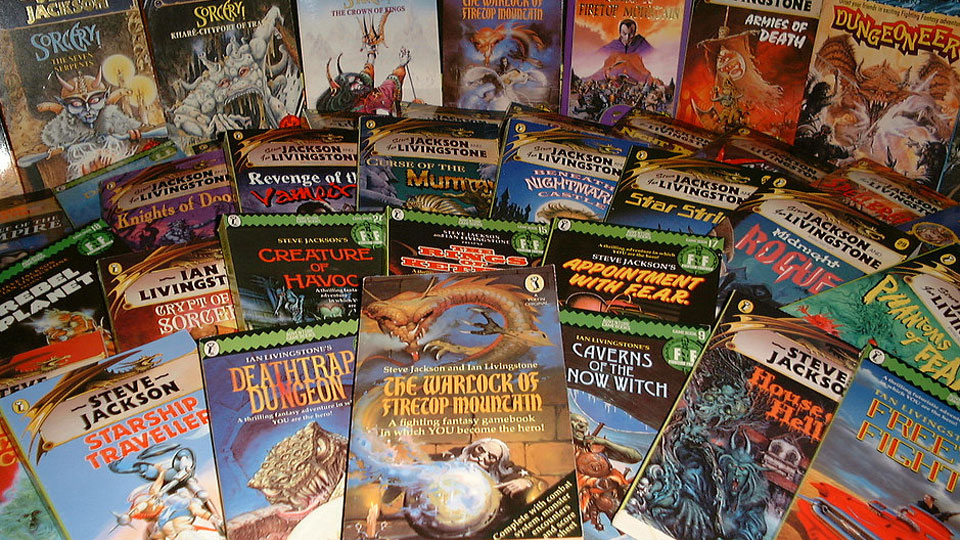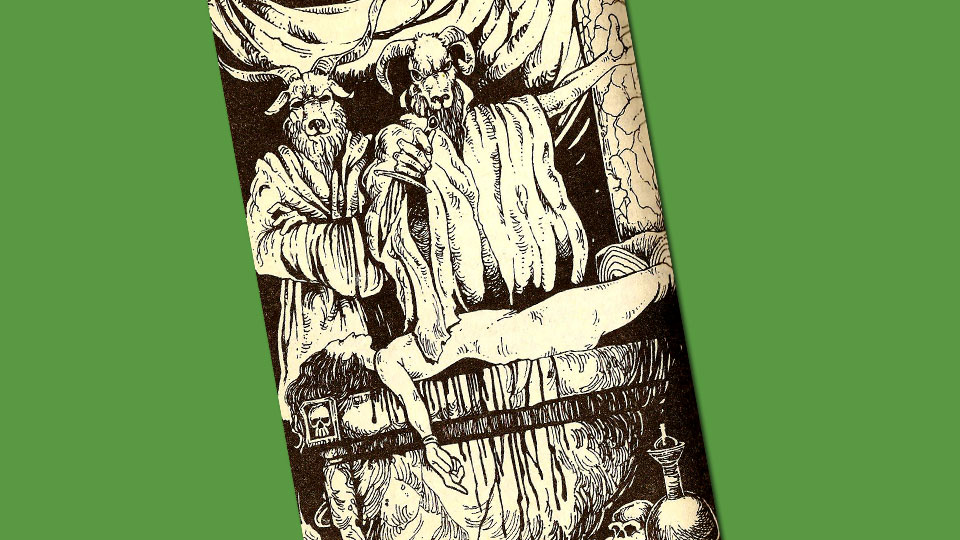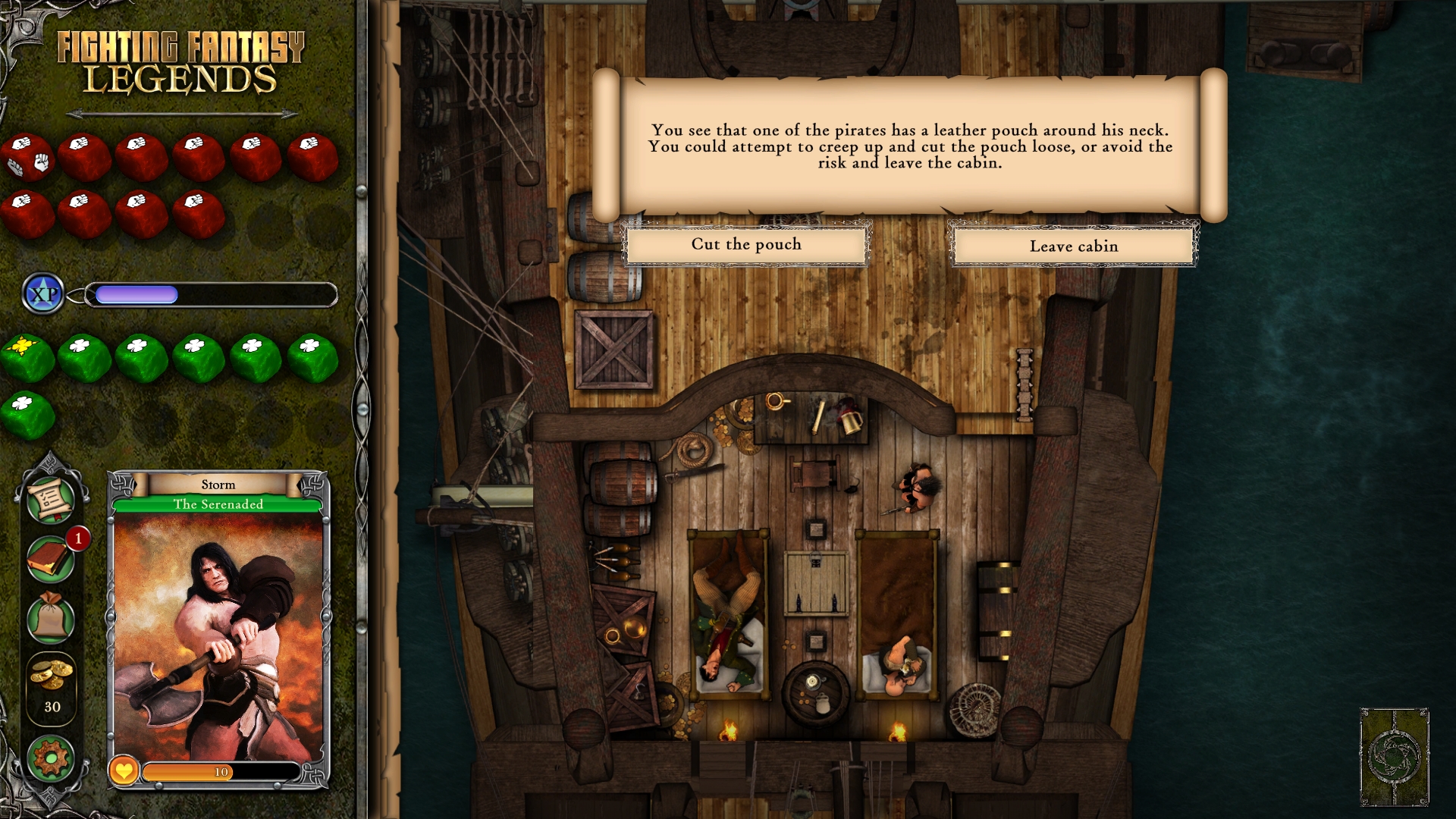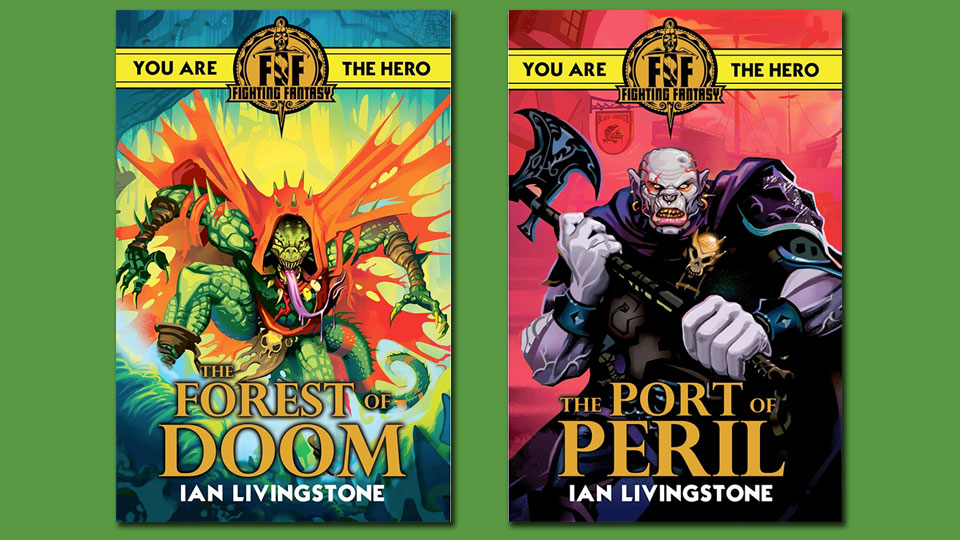When games consoles were bookshelves: celebrating 35 years of Fighting Fantasy books
Turn to page 4 to read the feature, head to page 301 to MEET YOUR DOOM

My first games console was a bookshelf. Long before I felt the call of Skyrim’s icy tundras, tackled the complex dungeons of Zelda or battled the undead foes of Dark Souls, I was exploring vast fantasy worlds through the pages of books.
The Fighting Fantasy novel series had it all – epic quests, hideous monsters and mysterious lands to visit. But they had a killer trick up their sleeves, too: they were interactive.
Armed with a pair of dice, a pencil, eraser and a character sheet, you’d create a hero to guide through the adventure laid out on the page before you. As you’d read along, you’d be presented with choices – should you take the left turn in the path, and face perhaps a marauding ogre head on? Or take the cowards option and sneak away by the right path?
For the first choice, you’d turn to, say, page 301, while for the second you’d turn to page 21, for instance, at which point each the narrative would branch off and the adventure would become all your own.
First published at a time when video games were still charmingly primitive, they were like nothing else – fully realised fantasy, sci-fi and horror worlds, in which you were in control of guiding your hero to glory, or to a grisly doom.
In the beginning was the words
It’s 35 years since the first Fighting Fantasy adventure, The Warlock of Firetop Mountain, was published. More than 50 books later, the series's creators Ian Livingstone and Steve Jackson are relaunching the books, and releasing a new videogame, Fighting Fantasy Legends, alongside the developers at Nomad Games, based on some of the most popular of the gamebooks.
The pair’s own story is worth revisiting. Having already formed the Games Workshop (the tabletop game sellers which also birthed the Warhammer universe), Livingstone and Jackson were well placed to capitalize on the growing interest in the nascent roleplaying game scene.
Sign up for breaking news, reviews, opinion, top tech deals, and more.

“Steve and I started Games Workshop in 1975 with another school friend John Peake. We acquired the exclusive distribution rights to Dungeons and Dragons the same year, and that really got us completely obsessed and immersed in roleplaying games,” recalls Livingstone.
“Having played and being involved with the game for six or seven years, we thought it’d be great to bring it to a wider audience, if we could replace the dungeon master with a book.”
“The time was right in the universe,” adds Jackson.
“Roleplaying was gaining in popularity – people were talking about solo books, and there were a couple around at the time, but not using a proper roleplaying system with dice and character sheets. That was what was mostly original about our take on it.”
We thought it’d be great to bring D&D to a wider audience, if we could replace the dungeon master with a book.
Ian Livingstone
It was the action-packed nature of the books that really set them apart. With a little simple arithmetic and and a couple of dice rolls, Livingstone and Jackson landed on a way to let readers battle enemies and ‘test their luck’ in the tense scenarios presented by each book.
“We stripped the roleplaying system down to its basics without dumbing it down, concentrating on three attributes, ‘Skill’, ‘Stamina’ and ‘Luck’, and created a branching narrative like the Choose Your Own Adventure books but attached the game system to make it more appealing to roleplaying gamers,” explains Livingstone.
“The system evolved over time but it came about thanks to a chance meeting with Geraldine Cook at Penguin Books when we used to run our Games Day conventions, where you’d have 1,000 people playing roleplaying games in a hall in Central London. She was in attendance and thought it was incredible, and wondered if we could write a book about this hobby.”
Super sales and beastly books
And so, after a few weeks of furious writing, The Warlock of Firetop Mountain was published. What had been conceived as merely an introductory guide to roleplaying games had morphed into its own interactive adventure.
It was an instant success, spawning a sprawling series set in its own fantasy universe that would stretch across dozens of books and genres, and achieve tens of millions of sales.
That success was in no small part down to the way the books were marketed – though ostensibly aimed at children, their covers were created by some of the finest fantasy artists of the day, often depicting gruesome monsters and otherworldly scenes.
The artist had drawn the scene with a woman, let’s say, not completely covered up.
Steve Jackson
“We used to have quite long arguments with Penguin right in the early days over what sort of covers we should have,” remembers Livingstone.
“Clearly because the Puffin imprint was aimed at children they wanted safe covers, so were more minded to suggest covers that had a toadstool with little gnomes sitting on top and butterflies flying around. We wanted covers that threatened to rip the faces off the readers! So we argued that we should use our Games Workshop illustrators, and that’s why Peter Jones, Russ Nicholson, and Ian McCaig all came onboard as we won the argument. To Penguin’s credit, they allowed us to use our artists.”
Though kids may have been enticed by covers that treated them like adults, the illustrations within pushed the boundaries of what could safely be called ‘children’s books’.
“I remember House of Hell had, like a typical 1950s b-movie horror film, a sacrifice sequence in it,” says Steve Jackson.
“The artist had drawn the scene with a woman, let’s say, not completely covered up. The imprint Puffin objected to that, and had the artist cover just a little bit more up before it went into the book.”

It had a lasting impact on those who read them, including Carl Jackson, Design Director at Nomad Games (and no relation of Steve’s).
“I remember being quite scared by the illustrations!” recalls Carl, who was recently tasked with re-imagining the frightening scenes for the Fighting Fantasy Legends game.
“I first read them when I was about 10 or 11. Something you don’t realise when you look back on them now is the way the illustrations were always from the reader’s (or the ‘hero’s’) viewpoint – the monsters were looking at you, the treasures were in front of you. That drew you in and made you feel like you were there, and being able to make decisions was amazing for a book for a kid that age. Rather than reading about what someone else was doing, it’s you that’s there, they’re your consequences, your victories.”
You are the hero
That sense of putting the reader at the heart of the action – literally staring into the inked eyes of the enemy – was an important part of the experience.
“Clearly it’s the empowerment, that you are the hero,” says Livingstone.
“That set off everyone’s imaginations. Linear books are a passive experience, Fighting Fantasy books are an interactive experience. Giving control to people was clearly very motivating, and of course the illustrations helped to spark the imagination even more so.”
To add to the excitement, tension and fear, was the fact that the books tended to be quite difficult.
Some people are quite masochistic and want to go down onto the poisoned spikes just to see what happens.
Ian Livingstone
“Steve tended to have... his [books] were a little bit more difficult than mine!” says Ian.
“We got an early taste of that because he was the culprit who designed the Maze of Zagor in Warlock of Firetop Mountain [a notoriously tricky area in the first Fighting Fantasy book].
“But you never know which way people are going to choose – some people are quite masochistic and want to go down onto the poisoned spikes just to see what happens, and some that we lure to their doom on purpose. I call it sprinkling rose petals towards quicksand. That’s the joyful part for me – designing things to lure people to their ultimate doom. That always makes me chuckle.”
“One of the things about Fighting Fantasy is that it attracts the more intelligent reader. They like to solve the quest – it’s basically a puzzle getting from the start to the finish, and they want to prove to themselves and to others that they can actually beat this book,” adds Steve.
Reimagining old adventures
The Fighting Fantasy books have been no stranger to adaptation. In the 1980s they were turned into the phone-in F.I.S.T (Fantasy Interactive Scenarios by Telephone) series, the '90s saw Deathtrap Dungeon turned into a 3D platformer, and recent years have seen the books faithfully rebuilt as mobile apps. Fighting Fantasy Legends, released this summer, is perhaps the most ambitious take on the books yet.
It combines three early books in the series (The Warlock of Firetop Mountain, Citadel of Chaos and City of Thieves) and turns them into a roguelike game. All the original story beats are present, but there’s now also a levelling system, a de rigueur collectible card system and, of course, a fully-realised world, drawn in full from a '90s-aping overhead viewpoint.

“It was just nice to see the world in a way that hadn’t been seen before,” explains Carl of the overhead viewpoint.
“Places like Port Blacksand where City of Thieves takes place is a nice big open sprawling city, so we thought it’d be nice to allow the player to have a feeling of knowing where they were, which direction they’d come from and are going to. The town from above allows us to show more detail – if it was a three-quarter view or a 3D game, you may lose some of that. And it was also a nod back to some of the roleplaying games of the late '80s and early '90s that were all primarily top down, especially Japanese roleplaying games.”
Carl had the difficult role of realising areas and situations that may not have been fully pictorially illustrated in the books. Doing so without stepping on the imagined memories of veteran readers was a delicate task.
That feeling of learning and overcoming a challenge a little amount each time, getting slowly better is a nice feeling.
Carl Jackson, Nomad Games
“We look at the descriptions of the places you can go to and maybe filled in some of the reasoning why it might be like that,” he explained.
“For example, with Firetop Mountain, when you look at the first third of the map is like an old orc barracks area, with orcs and goblins all on guard duty. So we had to make it feel like that. In the book, sometimes there’d be no description of a room at all – it was more about what was happening in there, when you were attacked, or perhaps there’s someone being tortured.
“We’ll add little details: there’s a prison cell where a guy has been trying to escape for 30 years, so we added little hints that he’d been trying to escape, like a little tunnel at the back of a room with a spoon on the floor he’d been using. Nice little nods to a feeling that this is a real place.”
And, like the books that inspired it, Legends, whether played on mobile devices or on a PC, is a considerable challenge.
“It kind of surprised me,” admits Carl.
“I’m quite often put off by very difficult games. I usually play for the story and setting, but things like Dark Souls people play because they know they are being presented with a challenge right from the beginning. That feeling of learning and overcoming a challenge just a little amount each time, getting slowly better is a nice feeling. And that’s the same in this game – it is very difficult in the beginning, but what you very quickly realise is that most of the encounters don't have to be dangerous when you learn what the different choices are.”
It’s just the sort of adaptation Steve and Ian have longed for, it seems.
“I think Carl’s done a brilliant job,” says Ian.
“We’ve all been in the videogame industry [Livingstone headed up publisher Eidos when the Tomb Raider series was conceived] as well as the roleplaying books industry, but he and his team have evolved all the systems so that they have that zen flow through the game. It’s not too easy that you get bored, it’s not so difficult that you put people off – if you do the right thing you will ultimately be able to get through easier than you would if you had just tried to blitz your way through. They’ve gone to great pains to ensure that if you approach it in the right way you will succeed.”
The five-fingered bookmark
One thing that is missing, however, is a Fighting Fantasy stalwart, even if it wasn’t something Jackson or Livingstone ever intended – the ability to cheat.
“We used to call it the five-fingered bookmark,” says Livingstone of the way people would hold the page they were leaving through the dangerous and winding narratives, just in case a nasty shock awaited at their destination.
“You’d see people on trains and buses with multiple people with fingers over multiple pages. Which is great! Why not? If that’s what you want to do, who are we to say no? It’s not really cheating, it’s peeking around the corners!”

Fighting Fantasy, in both this videogaming reimagining and the relaunched book series, exist now in a very different media landscape to the one in which the series was initially conjured. Video gaming is now a Hollywood-rivalling, spectacle laden medium, while kids spend just as much time on their own smartphones as they do reading books. But both Steve and Ian believe all can co-exist happily.
Videogames, mobile phones, PC adaptations, they’ve all been additive rather than at the expense of the books.
Ian Livingstone
“It’s interesting to see how this all develops,” muses Steve. “I can remember Ian and I having a conversation on what the future had in store, and that’d it’d be video games taking over from table topping and roleplaying. But actually they haven’t, in that they all exist now.”
“Videogames, mobile phones, PC adaptations, they’ve all been additive rather than at the expense of the books,” believes Ian.
“What’s great about the 35th anniversary is that children who read them in the 1980s now have their own children, and are passing the baton, so to speak. Normally children reject anything their parents say is cool, but Fighting Fantasy seems to resonate and strike a chord just as much as they did back in the ‘80s.”
Leaving a mark
But the influence of the Fighting Fantasy series is cemented, ingraining themselves in the memories of today’s game creators, and helping forge a path for the complex narratives of today’s video game RPGs.
“We’re delighted that we’ve had an influence on many video games,” says Livingstone.
“We’re told that the designer of Dark Souls [Hidetaka Miyazaki] used to read Fighting Fantasy when they were published in Japanese. They were a big influence on his approach to design. We’re also told that the designers of The Witcher games used Fighting Fantasy gamebooks as source material for the scenarios they created. And of course Telltale.

“But you can’t say it’s a direct result,” adds a modest Livingstone. “You can certainly say we’ve had an influence, and we’re very proud to have had an influence on the video games market in this particular genre. It’s very satisfying.”
And, after all these years, Livingstone and Jackson still love, and find time to play, the roleplaying games they helped to popularise in the first place.
“We meet regularly, every two or three weeks and play mainly German boardgames and card games,” says Jackson.
“It’s a games night that’s been going on with some of our gaming friends from the industry for, what, 25 years or something like that!
“[Fable creator] Peter Molyneux is a member, Clive Robert of 505 Gaming is a member and two other non-industry friends,” laughs Livingstone.
"We run a spoof gentlemen’s club called The Games Night Club, we have a trophy, we keep a record of the points total, and at the end of the year we award the winner.
"I write a newsletter for a circulation of six, we’re on issue 455 at the moment!”
Fighting Fantasy Legends is out now on PC, Android and iOS devices. The re-launched Fighting Fantasy book series is published by Scholastic and is available in all good bookshops.

Gerald is Editor-in-Chief of Shortlist.com. Previously he was the Executive Editor for TechRadar, taking care of the site's home cinema, gaming, smart home, entertainment and audio output. He loves gaming, but don't expect him to play with you unless your console is hooked up to a 4K HDR screen and a 7.1 surround system. Before TechRadar, Gerald was Editor of Gizmodo UK. He was also the EIC of iMore.com, and is the author of 'Get Technology: Upgrade Your Future', published by Aurum Press.